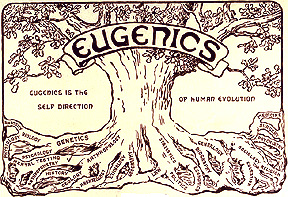
from the American Philosophical Society
and the Eugenics Archives
| T H E N I H C A T A L Y S T | S E P T E M B E R – O C T O B E R 2001 |
|
|
|
Cold Spring Harbor ArchivesAMERICAN
EUGENICS:
|
text
and photos by Fran Pollner |
 |
|
from the American Philosophical Society |
|
"Eugenics
is the self direction of human evolution"—the philosophy of
a movement in American history now the subject of a website
from Cold Spring Harbor Laboratory,
where a workshop was recently held examining possible parallels between
past and present
|
It’s unlikely that Gregor Mendel expected that his obscure life’s work would be rediscovered after his death and recognized as an extraordinary addition to the understanding of biological organisms.
It is even less likely that he could have foreseen that his painstaking counts of peas of different colors and shapes—the basis of the science of genetics—would spawn a eugenics movement led by scientists who posited a single-gene causation of lunacy, pauperism, criminality, sloth, epilepsy, and other traits they deemed loathsome.
But, indeed, Mendelian genetics, born in the second half of the 19th century, was used in the first half of the 20th as an allegedly scientific springboard for laws that imposed constraints on immigration, marriage, and reproduction in the United States. Not only did some scientists promote eugenics—the science of being well-born—those who did not did little to oppose it.
One hundred years later, on the cusp of a new century, the mapping of the human genome opened another door to gene-based strategies to improve human health. Today, however, many eyes are also open—to the potential for abuse.
Facing the Past
Among the vigilant are scientists at Cold Spring Harbor Laboratory (CSHL) in New York, perhaps more attuned than other researchers to how science can veer off course because of the checkered history of CSHL.
Now a world-class enclave of research and teaching in the biological sciences, CSHL was in its early decades the focal point of the American eugenics movement. Its officers produced and disseminated the movement’s newsletter and from 1910 to 1940 ran the Eugenics Record Office (ERO), the repository of the movement’s scientific papers, monographs, and family pedigrees gathered by fieldworkers trained at CSHL.
The ERO gave scientific weight to the prejudices that drove the enactment in 1924 of the U.S. Immigration Restriction Act and Virginia's Racial Integrity Act. It also crafted a model law used by 32 states to allow the compulsory sterilization of America’s "unfit." This model was later adopted in Nazi Germany and earned Harry Laughlin—ERO director and the model’s chief architect—an honorary degree from Heidelberg University in 1936, a year after its Jewish faculty had been expelled.
The rise and rationale of the American eugenics movement is now exposed in words and images at a CSHL website—with funds from a grant from NHGRI’s ELSI (Ethical, Legal, and Social Implications of Human Genetics Research) program.
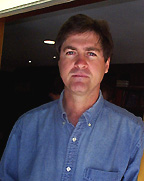 |
|
David
Micklos:
He and co-principal investigator Jan Witkowski decided to shine a giant beam onto what Micklos terms a "dark and relatively cloistered part of American history." |
The Image Archive on the American Eugenics Movement is co-directed by Jan Witkowski, director of the CSHL Banbury Center, and David Micklos, director of the CSHL Dolan DNA Learning Center. Its aim is that history not repeat itself. To that end, CSHL hosted a workshop on "American Eugenics and the New Biology: Perspectives and Parallels." The workshop was attended by scientists, legislators, ethicists, judges, and some journalists and was designed to cast the issues and the archives as widely as possible into the public arena.
Garland Allen, a biology professor at Washington University in St. Louis who wrote two of the archive essays—on the social origins of eugenics and on its research flaws—tracked the ascendancy of the stitched-together science of eugenics into public policy.
What began in some scientific circles as excitement over the principles of Mendelian inheritance—that a "unit character" passed from parent to offspring produces a phenotype that could explain the inheritance of such traits as hemophilia—was molded into a movement that championed the science of human improvement through better breeding—an extension of agricultural and animal breeding principals to humans.
Eugenics was not the pet of the lunatic fringe; its intellectual leader, Charles Davenport, had taught at Harvard for 10 years and was a member of the National Academy of Sciences when he prevailed upon the Carnegie Institution of Washington to fund a research station at Cold Spring Harbor to study evolution by breeding farm animals and crops. Soon after, he secured funds for the ERO, which existed from 1910 to 1940 and boasted a board of distinguished scientific advisors. Laughlin, the ERO director, was appointed the eugenics expert to the House Committee on Immigration and Naturalization, where he presented charts on the prevalence of criminal behavior among those "biologically incapable of adapting to a complex society" and other proof of the inferiority of newer immigrants to America.
In the Name of Science
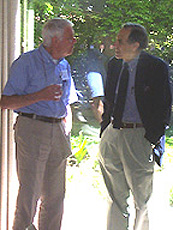 |
|
Gar
Allen (left) and Neil Holtzman
|
Other "scientific" findings of the American eugenics movement included:
![]() "Degeneracy" statistics showing that the birthrates of the "pathological"—criminals,
the insane, deaf-mutes, the tubercular—were swamping those of "normal
stock." The former reportedly had an average of six children; the latter,
such as British intellectuals and Harvard graduates, had an average of 1.5 and
2 children, respectively.
"Degeneracy" statistics showing that the birthrates of the "pathological"—criminals,
the insane, deaf-mutes, the tubercular—were swamping those of "normal
stock." The former reportedly had an average of six children; the latter,
such as British intellectuals and Harvard graduates, had an average of 1.5 and
2 children, respectively.
![]() Anecdotal evidence that marriages ought to be made in the eugenics clinic, such
as the case of one well-born man who had dallied with a "feeble-minded
tavern girl" and then married a "worthy Quakeress." The first
union formed a "line of hereditary defectives"; the second produced
only "pillars of society."
Anecdotal evidence that marriages ought to be made in the eugenics clinic, such
as the case of one well-born man who had dallied with a "feeble-minded
tavern girl" and then married a "worthy Quakeress." The first
union formed a "line of hereditary defectives"; the second produced
only "pillars of society."
![]() Pedigree charts purporting to demonstrate the passage of a trait—such as
manic-depression, pauperism, and pellagra—through the generations. One
study concluded that scholarship was a sex-linked trait since it showed up only
among the male members of families that had been tracked.
Pedigree charts purporting to demonstrate the passage of a trait—such as
manic-depression, pauperism, and pellagra—through the generations. One
study concluded that scholarship was a sex-linked trait since it showed up only
among the male members of families that had been tracked.
Ten thousand family histories were accumulated by CSH fieldworkers, said Elof Carlson, a geneticist and science historian at the State University of New York, Stony Brook. These were used to advise individuals regarding the eugenical fitness of proposed marriages. The ERO produced a Classification of Human Stock that defined "the fit" (those with genius, special skills, intelligence, courage, unselfishness) and "the unfit" (those who were socially inadequate, feeble-minded, paupers, epileptic, deformed, and "cacaesthenic," or ugly). Genetics was proffered as the sole source of fitness. Claiming that their findings conformed to Mendelian principles, scientists presented studies of the offspring of "retarded" individuals that yielded retardation rates greatly exceeding any that would be predicted by Mendelian genetics.
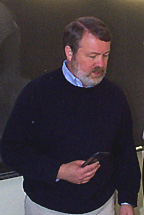 |
But, Carlson noted, other geneticists—even those who were not eugenicists—did not challenge these papers. And the few demurrals that eventually were published appeared, unheralded, in obscure specialty journals not read by the general public or even most scientists. They were modest, polite, and did nothing to counter the laws and public policies based on eugenics.
It would have taken just three hours of research in books available at the time to refute every argument made by eugenicists, observed Paul Lombardo, a historian and lawyer who teaches bioethics and health law at the University of Virginia, Charlottesville.
Arguments that should have been made were not, he said.
"We have an obligation to remember this politeness of our forebears. We must critique our colleagues—not just subtly and in small footnotes behind closed doors. The science community and the media have an obligation," he said, noting that the atrocities that achieved the status of law in this country in the 1920s remained in effect for more than four decades. Immigration restrictions against Italians, Russians, Turks, and others were operative until the 1960s; it was not until 1967 that the racial integrity (anti-miscegenation) law was overturned; and under the authority of the eugenical sterilization law (adopted by 32 states after the Supreme Court found, in the words of Justice Oliver Wendell Holmes, Jr., that "three generations of imbeciles are enough" in the notorious Buck v. Bell case), 66,000 people were sterilized by 1963. The last documented forced sterilization occurred in Virginia in 1979.
In the Light of Today
According to his definition of eugenics—interference with individuals’ procreative choices in order to attain a societal goal—eugenics lingers in our society, perhaps more dangerous because it is not so obvious, cautioned Neil Holtzman, professor of pediatrics at the Johns Hopkins Medical Institutions in Baltimore.
Eugenics may lurk under the masks of compassion and cost savings. At the dawn of prenatal diagnosis, he said, some scientists maintained that:
![]() Carriers of recessive hereditary defects should be warned against or prohibited
from having children.
Carriers of recessive hereditary defects should be warned against or prohibited
from having children.
![]() Parents have a duty to abort if a severe birth defect is detected.
Parents have a duty to abort if a severe birth defect is detected.
![]() Parents should feel guilty if they continue to reproduce kids with cystic fibrosis.
Parents should feel guilty if they continue to reproduce kids with cystic fibrosis.
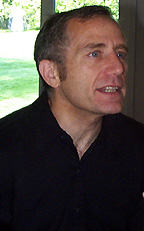 |
Society needs to be alert to the abuse potential of genetic advances, he emphasized—lest such occurrences as these turn out to be modern landmarks along a slippery slide to the past. Some more recent concerns:
![]() The implied obligation to screen for carriers of such conditions as sickle cell
anemia or Tay-Sachs.
The implied obligation to screen for carriers of such conditions as sickle cell
anemia or Tay-Sachs.
![]() A recent survey of managers of newborn screening programs in which 19 percent
included as an important goal of newborn screening to "identify children
who might be unsuitable for genetic reasons to reproduce."
A recent survey of managers of newborn screening programs in which 19 percent
included as an important goal of newborn screening to "identify children
who might be unsuitable for genetic reasons to reproduce."
![]() Surveys of genetics professionals and primary-care physicians that show a proclivity
to encourage prenatal diagnosis for such conditions as spina bifida, Down syndrome,
cystic fibrosis, sickle cell anemia, achondroplasia, and Klinefelter’s
syndrome.
Surveys of genetics professionals and primary-care physicians that show a proclivity
to encourage prenatal diagnosis for such conditions as spina bifida, Down syndrome,
cystic fibrosis, sickle cell anemia, achondroplasia, and Klinefelter’s
syndrome.
Holtzman urged that any remaining sterilization laws be repealed; that the stigma attached to those with genetic disabilities be eliminated; that full care for all infants born with prenatally detectable conditions be guaranteed; and that genetic counselors be trained to be nondirective.
"To use eugenics around sexual orientation is a real live threat," said NCI’s Dean Hamer, whose reported findings that gay brothers shared DNA markers on the X chromosome more often than expected suggested a genetic component to male sexual orientation. They also suggested that sexual orientation is not all genetics, he said. Nonetheless, as soon as his and other limited, preliminary data were reported, there was talk of prenatal screening for the "gay gene"—with prominent individuals suggesting that selection on that basis is acceptable.
The public, he said, and
especially judges—who make and overturn laws—need to learn, at the
least, how to identify and thwart such misuse of science. ![]()
| BLUE RIBBONS FOR 'FITTER FAMILIES' | ||
Steve Selden, of the University of Maryland, College Park, and author of Inheriting Shame: The Story of Eugenics and Racism in America, presented a slice of American life from 1911 through the 1920s—the Fitter Families Contests that, like judging livestock, became a staple of state fairs all over the country. Under the eye of health-care professionals, contestants were assessed in examining rooms covered with posters illustrating how "some people are born to be a burden to the rest." One poster declared that a person of poor hereditary stock is born every 16 seconds and "costs us $100" every 15 seconds, while a child with a high IQ is born only once every seven minutes. These contests were fostered by the Race Betterment Foundation, funded by the J. H. Kellogg fortune, encouraged by the Women’s Home Companion, and legitimized by the eugenics movement. CSHL workshop participants
compared such propaganda to the Nazi rationale for murdering people whose
care would exact too high a price from hard-working Aryans. And some were
moved to sound cautionary notes about carrying modern prenatal diagnosis
and managed care to extremes. |